homemade pizza gallery (and notes, tips, etc.)
homemade pizza gallery (and notes, tips, etc.)
-
-
-
-
-
-
Post #91 - November 1st, 2009, 8:33 pmSo I've been playing around with different types of flour--recently trending towards a 3:1 mix of bread:00 flour. I plan on ordering some high gluten flour from King Arthur to try that as well. I ran out of bread flour this weekend and ended up making pizza dough which was 3:1 00:bread. Came out a little tough and I didn't get that nice puffy edge on the crust (I know there's a name for that, but I haven't been on the pizza forum website recently and I can't remember what it is). I think I've resigned myself to the fact that the 00 doesn't work that well for me, well, until I get that oven I want imported from Naples...
Here are 2 recent pies...
#1: Inspired by G Wiv--pear, gorgonzola, rosemary and pancetta
#2: From the Reinhart cookbook (well, loosely)--roasted eggplant, onions, tomatoes and olives with lemon + feta, caciocavello and asiago
Pre-cheese application
Finished pie
-
-
Post #92 - November 2nd, 2009, 4:08 pmawesome looking pizzas there, especially # 2 for my tastes.

-
-
Post #93 - November 4th, 2009, 5:25 pmLooking for a little advice-I just bought a pizza stone for the grill, the PizzaQue and it's going to be my first time using it tonight. I have a Weber Genesis Gas Grill. We're not eating until 8 so I have time...
How long should I heat the grill/stone? How hot should I get the grill going? Should I set all burners on high?
I am worried about the bottom burning-Any help from all you experts?
Here is the stone I got. I got it at the Backyard Grill store in Wilmette, not Sur La Table:
http://www.surlatable.com/product/id/198197.do?mr:trackingCode=F76CAEDC-D781-DE11-B7F3-0019B9C043EB&mr:referralID=NA
-
-
Post #94 - November 5th, 2009, 10:59 amtoppings included smoked salmon, prosciutto,
caramelized onions, chanterelle mushrooms, portabella mushrooms, burbon soaked dates, artichoke hearts, and a blend of cheeses. Oak is king for cooking pizza. Cooking times averaged around 2-3 minutes.
Oven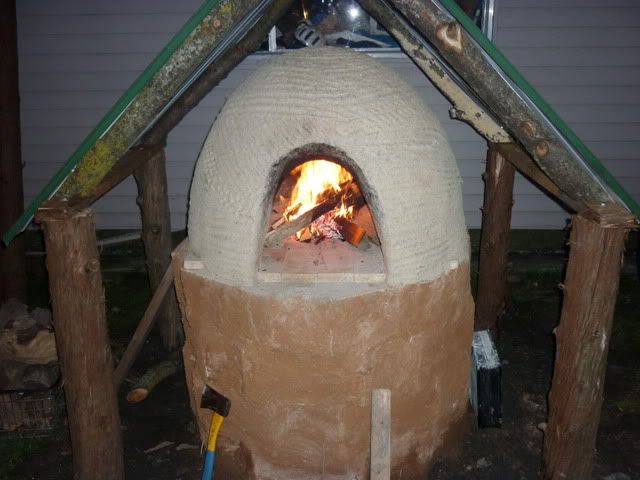
Proofing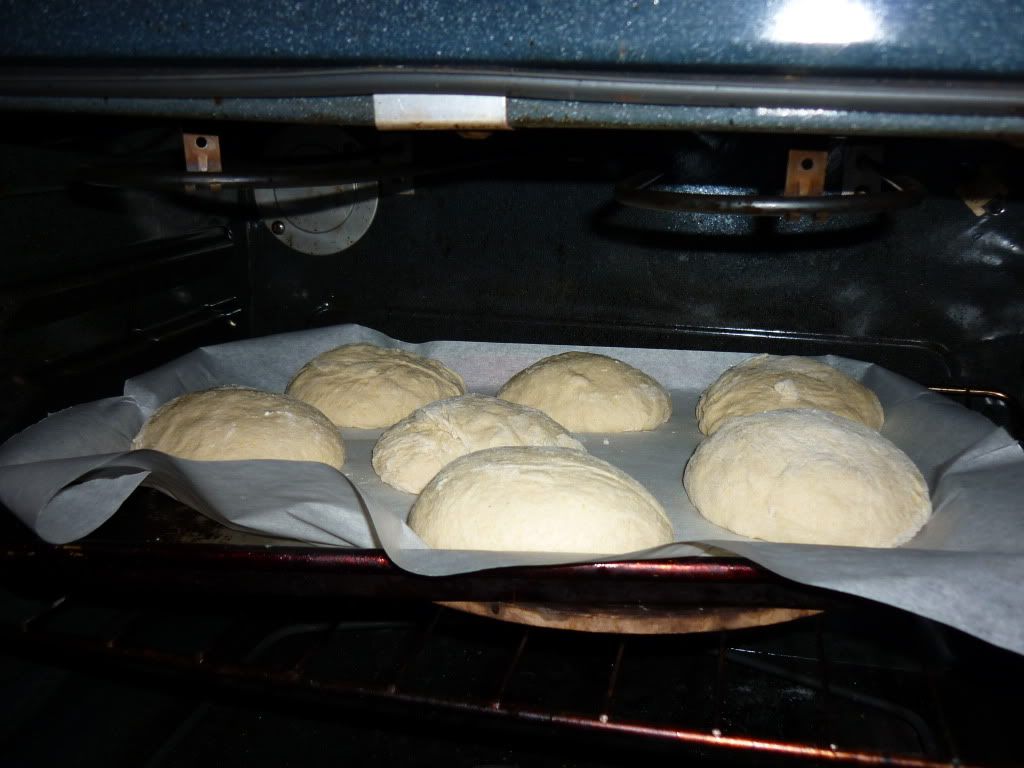
Cooking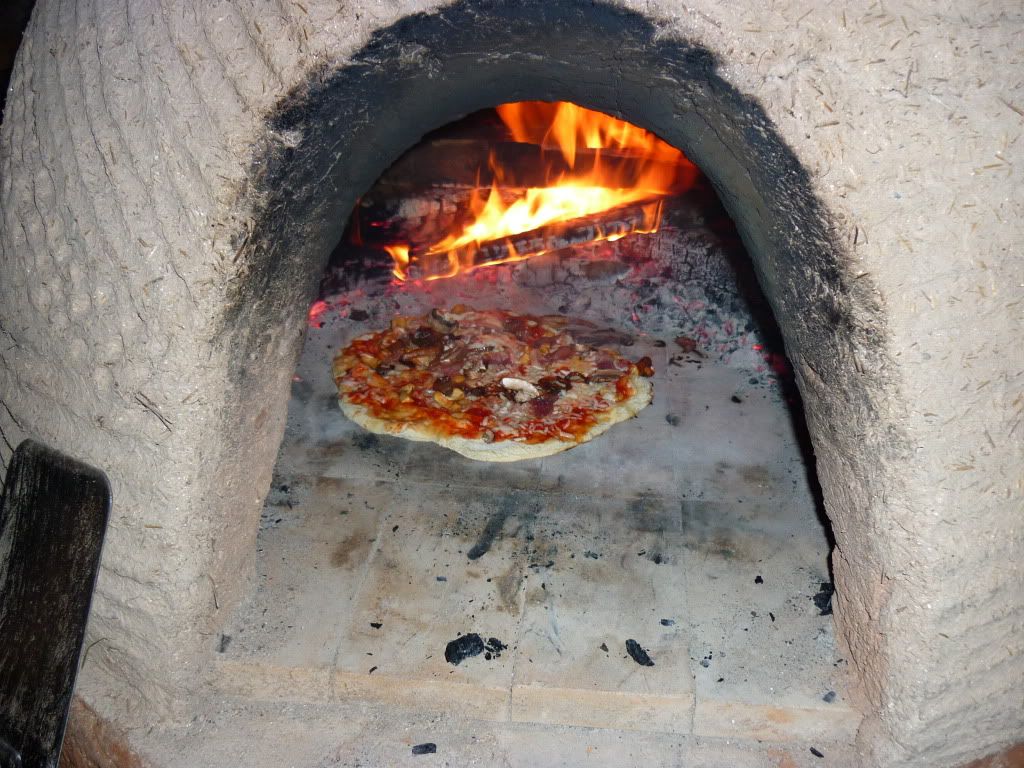
Time to eat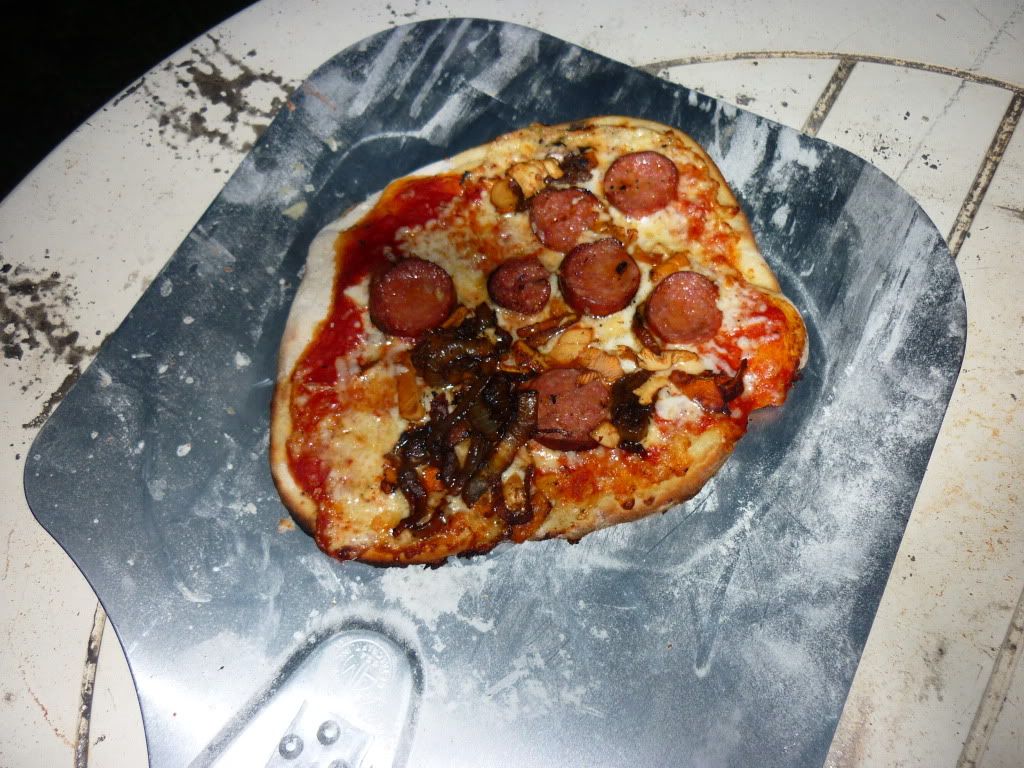
-
-
Post #95 - November 5th, 2009, 12:25 pmwhoa....
I am having major oven envy right now.
just gorgeous drshoebocks.
-
-
Post #96 - November 5th, 2009, 2:07 pm

Thanks to ReneG, who photographed, then ate, this pizza.
-
-
Post #97 - November 5th, 2009, 2:16 pmI have now seen the pizza I will one day marry and make my own...
-
-
Post #98 - November 6th, 2009, 10:53 amBeautiful pizza JeffB...
Any tips on how to get my crust to look like that? What kind of yeast starter/flour are you using? Oven set-up? Flour? Any insight would be appreciated...
-
-
Post #99 - November 6th, 2009, 1:00 pm

Thaiobsessed, the top floor of this thing houses a Forno Bravo pizza oven, shipped as a modular "kit," which is typical for these kinds of ovens. (BTW, this is the same unit that houses a pig pit.) I use cherry, apple and maple, because that's what's cheap and easy in the area of Michigan where the oven is. I think the fruit woods work exceptionally well. There's a slight flavor that I think the woods impart, but more to the point, the fruit woods tend to have just the right size, shape and ease of lighting and burning.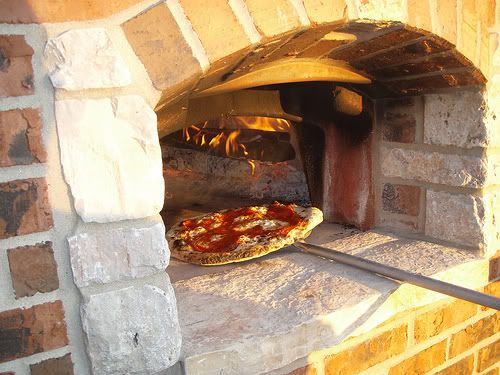
The oven can get up around 1000 degrees without too much effort. However, I find that after I get to 800-plus I get into the attributes that some people don't like/appreciate about the Neapolitan style -- for example, a softer, pale cornice marked with some bubbly black char and limited browning of toppings. I like that style quite a bit. Bill/SFNM's pies are textbook examples. And it's really what you get at Spacca on a good day, but it's not completely "understood" and well-loved by all, including most in my family. Many prefer the supposed "new American" style of pizza now exemplified by Great Lake and Coalfire. At the super-high temps, you also have less time to play around with the pizza; the oven is far less forgiving at that temp to minor mistakes (like taking a sip of beer for a few seconds). I work at around 800 on the floor of the oven, sometimes slightly lower. Instead of taking 90 seconds, it takes a couple of minutes, so we are not talking about a ton of time in any event.
The dough in the pictured pie is a pretty standard 3:1 mix of Caputo 00 purchased at JP Graziano and King Arthur bread flour, respectively. My family enjoys the chew of an even proportion, though. I long followed the proportions, if not the technique, from Jeff Varasano's site. (Frankly, I think some of the manifesto about specific times, mixer settings, etc. to be more voodoo than reality.) And, salt yes, oil no. Now I know how the dough is supposed to look and feel, so I just start with the basic proportions (about 1.5 Kg flour/L water) and add flour. I used good old Red Star as the yeast and did a 24 hr "cold rise," though I don't find same day room temp. rising to be either as tricky or inferior as others (Varasano again). I have used "boutique" yeasts before, and I would like to get my hands on a special starter, but the commercial yeast doesn't keep anyone from enjoying the pies. The toppings here are good Neapolitan canned tomatoes pureed with salt, oregano and olive oil, some provolone, fresh mozz from Belgioso (easy to find and pretty damn good for a mass-produced product), and some Romano. The pie pictured has more flour on the cornice than I'd like, but that pie and 8-10 others were all made outside on a warm and humid day [actually, the pie was "brunch" for the folks helping me with my 4th of July pig roast, thus the good photos (I don't take photos myself much)], so the dough was tacky and uncooperative. I would never use cornmeal, which I hate but is also a disaster in a very hot oven, IMO.
As far as tips, making pizzas is like a lot of simple things that are hard to do well. Repetition is key. Luckily, even expensive flour is pretty cheap. Beyond that, I'd say a lot of the problems I see in pizzas in this thread could be solved by using less (or no) oil in the dough and not working it so much when forming the uncooked pie. If you think of the dough like a mousse being spread out, that's what you want. You want the dough to change its shape but not its texture. Be patient. Once the pie is in the oven, leave it alone as long as you can stand it. Like an egg, a hamburger, or whatever, you need to allow the bottom to firm up before attempting to move it. But once you can move it, you should. Move it about from time to time so it's even and well cooked. And that's one of the things that's tough about using a traditional home oven or a Green Egg. You can't easily access the pie.
When making the dough, I agree 100% with the pros that it needs to be much wetter than you would expect when it is ready. 1/2 way between a cake batter and bread dough. They say pizza bubbles come as much or more from steam as yeast, and that seems right to me. It's not really a problem because you cut the dough to size and flour the ball, creating an outside layer you can work with while retaining the wetter interior. Last, something I do for toppings: use a very thin layer of sturdy cheese below everything else, including the tomatoes. Like a smear of mayo on a hamburger bun, this "waterproofs" the dough and eliminates problems created by wet ingredients and leaving them on the pie longer than optimal before cooking.
Happy to answer any specific questions beyond that...
-
-
Post #100 - November 6th, 2009, 5:40 pmdrshoebocks,
Amazing effort for a home setup. Looks fantastic.
-
-
Post #101 - November 6th, 2009, 6:30 pmHere is a video of a pie I made today:
-
-
Post #102 - November 9th, 2009, 12:20 pmJeffB wrote:

Thanks to ReneG, who photographed, then ate, this pizza.
Thanks to JeffB for making that beautiful pizza. It tasted every bit as good as it looks. Truly one of the best pizzas I've eaten.
Here's a shot of the same pizza in Jeff's wood-fired oven. You can see the two types of cheese that Jeff mentions above.
And here's another view of the beauty.
-
-
Post #103 - November 9th, 2009, 1:44 pmRene G wrote:And here's another view of the beauty.
Beautiful, simply beautiful. Outstanding looking pizza Jeff.
-
-
Post #104 - November 12th, 2009, 10:39 amJeffB wrote:

Would I be infringing on your intellectual property rights if I made this picture into a poster and stuck it up on my bedroom wall next to my picture of Lorenzo Lamas from 1985?
-
-
Post #105 - November 12th, 2009, 11:42 amInteresting issue. The pizza was my creation but the photo was ReneG's. I don't think chefs have had much success in extending copyright or trademark protection to ephemera such as tuna tartar and avocado mille-feuille (there was an extensive thread on this some time back), though I would advocate common law rights of publicity and privacy for really good pizzas. They have soul and personality as well as a particular proper geometry and theology (round or square, Chicago or NY orthodox, respectively). In this case, I will assert the pie's right to control its own commercial image because I eschewed privacy and thrust the pie into the public spotlight by posting a photo of it here, having also taken steps to assiduously cultivate, control and protect the pizza's wholesome image. I wouldn't want the pizza to show up on some nefarious site in bad company or be used to promote someone else's commercial venture. As far as the copyright goes, that's ReneG's. We will have to work up a joint licensing agreement. And don't try to "Obamanize" the pie. That one doesn't work.
So, yeah, go ahead.
-
-
Post #106 - November 12th, 2009, 3:59 pmJeff -- Wonderful looking oven and outstanding looking pies!
Bill/SFNM -- great little film and great looking pie!
Saluti e complimenti, amici miei!
AAlle Nerven exzitiert von dem gewürzten Wein -- Anwandlung von Todesahndungen -- Doppeltgänger --
- aus dem Tagebuch E.T.A. Hoffmanns, 6. Januar 1804.
________
Na sir is na seachain an cath.
-
-
Post #107 - November 12th, 2009, 4:04 pmJeffB wrote:As far as the copyright goes, that's ReneG's. We will have to work up a joint licensing agreement.
My understanding is Rene has sold image rights to the pie in question to Sandra Lee for her new line of Save-a-Step pizza pies.
It is a hell of a looking pizza, and one to which I aspire.
-
-
Post #108 - November 16th, 2009, 5:19 pmi'm late to the party
a few attempts at st. louis style pizza
:
...long before bacon was fashionable it was one of the more popular pizza toppings in st. louis pizza.
...crust is too thick on this one.
recipe: http://www.flickr.com/photos/danebrian/2672387345/
incidentally, if you're not wanting a st. louis style pizza but want an easy crust, the crust is great on a grill w/ more olive oil... pretty close to my ideal wood fire pizza type crust.
an attempt at a thicker crust pizza. w/ homemade bbq sauce, chicken .. etc
... i won't even scare you with my deep dish attempts. :]
-
-
Post #109 - November 16th, 2009, 8:39 pmWow, there have been some beautiful pies lately. JeffB, Bill/SFNM, ddane--I'm almost shy about posting mine.
JeffB, thanks for adding the details on the dough, oven, prep.
I dug up a recipe I had clipped from the NY times for chicken pistachio flatbread and used the topping on pizza.
Basically, chicken breast, pistachios, onions, scallions and bell pepper are pulsed in a food processor with sumac, zaatar. Finished product is sprinkled with sumac, zaatar and roasted red peppers. I added a little dollop of labne--I could marry labne...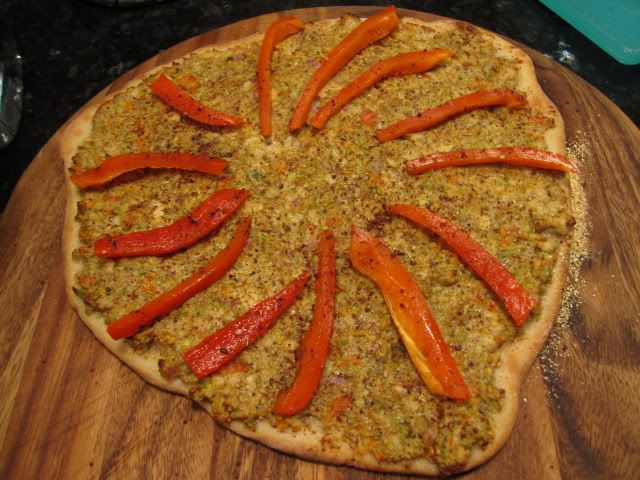
-
-
Post #110 - November 20th, 2009, 9:16 pmBill/SFNM wrote:Here is a video of a pie I made today:
Bill, I've been meaning to ask: what's that lift at the end all about?
-
-
Post #111 - November 22nd, 2009, 9:23 amI use King Arthur's Flour and Julia Child's dough recipe. It has cornmeal in the dough for a little extra crunch. I like to use quesadilla cheese for it's higher fat content and gooeyness. This pizza is salami, red onion, and garlic.

-
-
Post #112 - November 22nd, 2009, 10:26 amgastro gnome wrote:Bill, I've been meaning to ask: what's that lift at the end all about?
When baking a pie at over 900F for less than 60 seconds, the biggest challenge is ensuring that all parts of the pie are perfectly done at exactly the same moment. That window may only be a second or two. If I sense that the crust is about done, but the toppings may need a bit more time, I lift the pie for a few seconds to the top of the dome which is the hottest part of the oven. This gives a quick blast of heat to the toppings. Similarly, if I feel the toppings are ahead of the crust, I may use the peel to block the radiant heat from the fire.
-
-
Post #113 - November 25th, 2009, 7:52 amA few shots from last night's dinner.


(click for larger images)
I got an infrared thermometer to keep an eye on what's going on in the oven, and last night I was able to get my quarry tiles up to about 650.
Certainly no Great Lake, but I wasn't scolded by the staff, so that's a plus.
-Dan
-
-
Post #114 - November 25th, 2009, 8:03 amdrshoebocks, I need to know more about your oven. Did you make it yourself?
-
-
-
Post #116 - November 30th, 2009, 8:58 pmMore pizzas tonight - slightly wetter dough this time, same basic recipe. I bought some 00 flour at Panozzo's while picking up some speck, so I plan to try mixing that with my King Arthur bread flour and see how that changes things next time around.
Caramelized onions, fugi apple, and a bit of mozzarella, with La Quercia speck layered on after cooking
I really liked this one, though I wish I had a more interesting cheese to put on it. I wanted a little gouda or something, but all I had was some cheap mozzarella.
Side shot
Crust of a fresh mozzarella and mushroom pie
(click for larger images)
I do wish I had the heat for some char, but overall I'm really happy with how things are turning out.
I want to fire up my Weber and see what I can do outside, thought my last set of Weber kettle pizza baking experiments gave me good charred bottoms and barely cooked tops. I've got a few ideas on how I can improve on those results, so I just need to get out there and try.
-Dan
-
-
Post #117 - December 2nd, 2009, 2:52 amMy girlfriend made a montage to our dog spot. It was a bear on the peel, but tasted delicious. Wood levels are high these days, but the chill outside deters me from making more. Next project is a door for our oven.

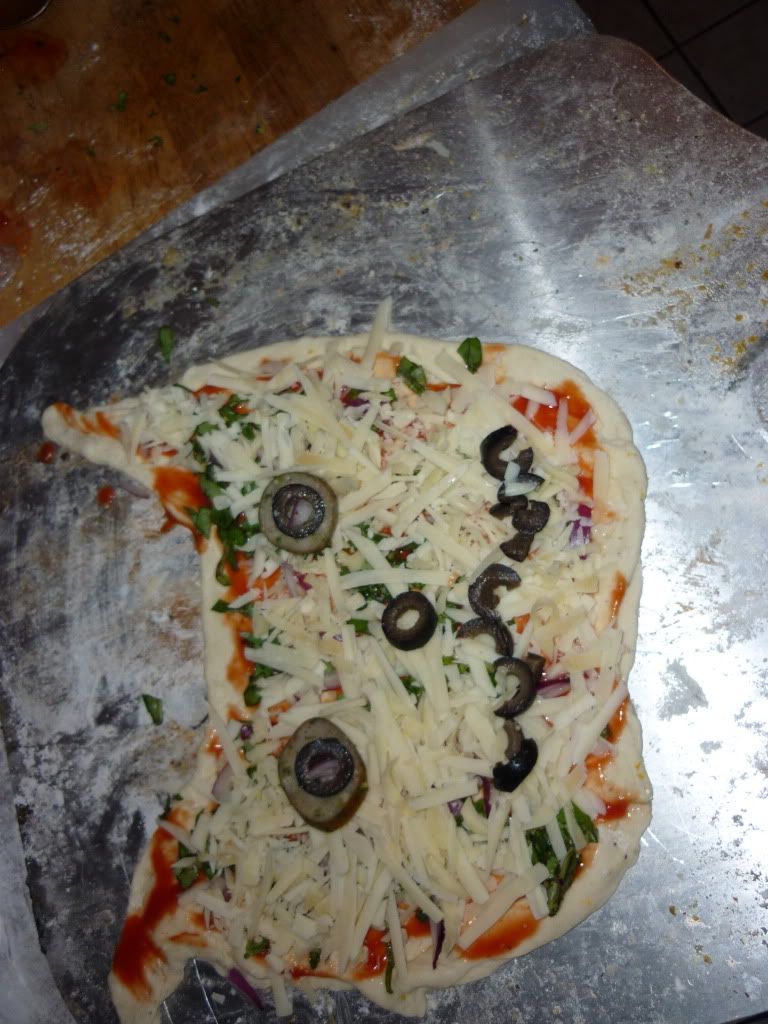
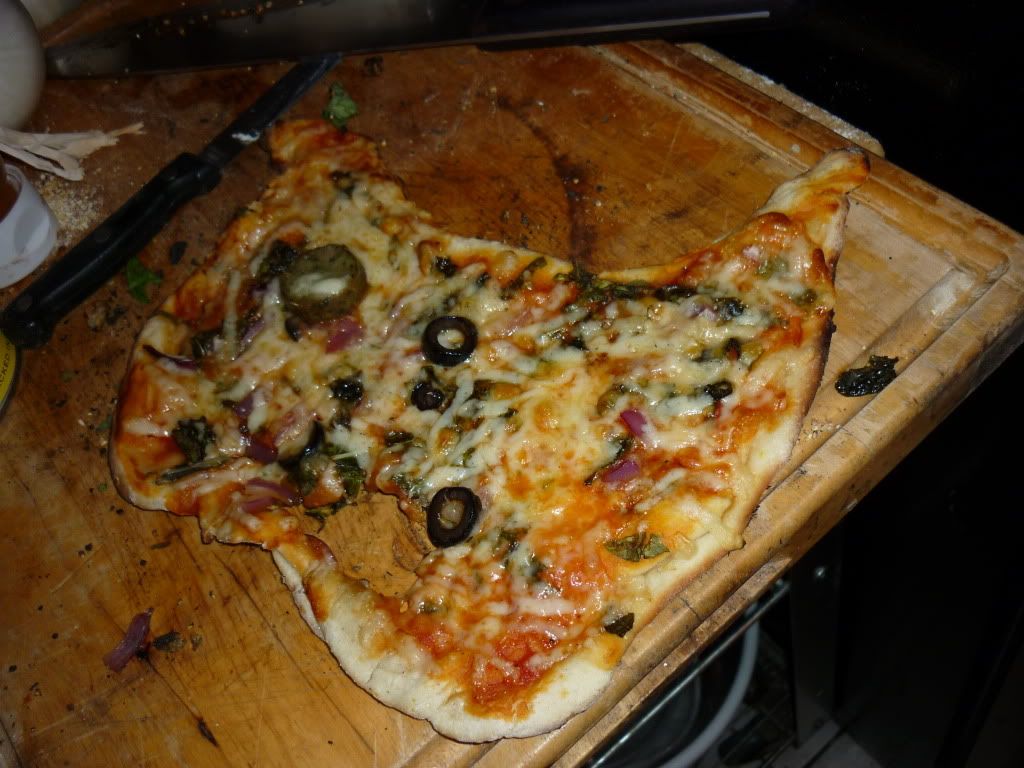
-
-
-
Post #119 - December 13th, 2009, 2:40 pmGrrr! Now I'm hungry after looking at these pics.Ava-"If you get down and out, just get in the kitchen and bake a cake."- Jean Strickland
Horto In Urbs- Falling in love with Urban Vegetable Gardening
-
-
Post #120 - December 25th, 2009, 12:57 pmHad a real "Jones" for a homemade pizza after reading this thread. Made up a "quick and dirty" nothin' fancy pie from bread machine dough, homemade sweet Italian sausage, home canned sauce, kitchen window sill herbs and some "el-cheapo" shredded Mozz combined with some forgettable smoked Polish cheese.
Tasted good and satisfied the "Jones".

Not gourmet but definitely edible.You can't prepare for a disaster when you are in the midst of it.
A sensible man watches for problems ahead and prepares to meet them. The simpleton never looks, and suffers the consequences.
Proverbs 27:12





